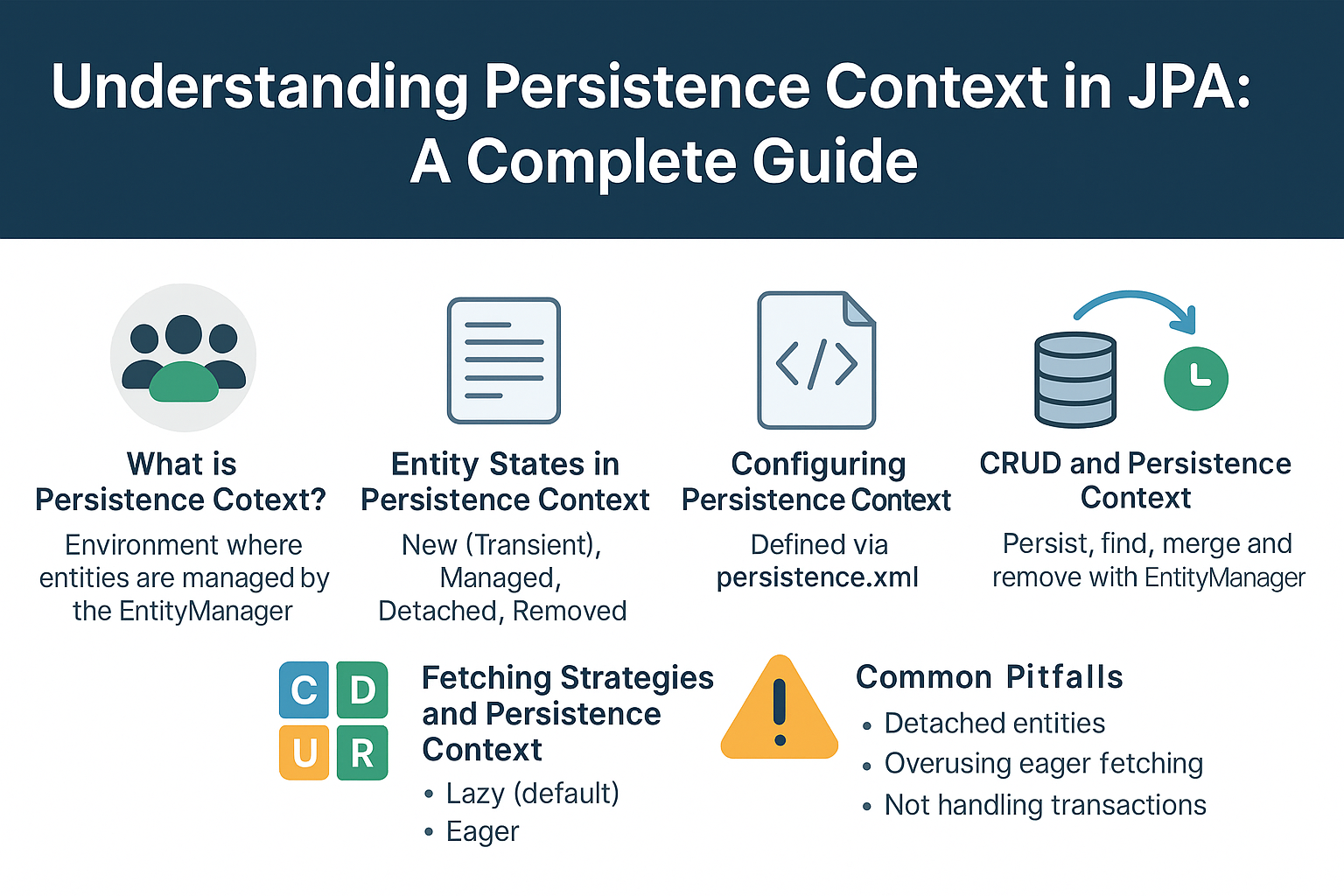When working with JPA (Java Persistence API), one of the most important concepts is the Persistence Context. It is the core mechanism that ensures entities are tracked, synchronized, and managed efficiently. Without understanding persistence context, developers risk running into issues like detached entities, stale data, or unnecessary queries.
In this tutorial, we’ll explore the Persistence Context in JPA, its architecture, entity states, examples, and best practices for real-world applications.
What is Persistence Context?
- The Persistence Context is the environment where entities are managed by the EntityManager.
- It acts like an in-memory cache that keeps track of entity states and ensures they remain consistent with the database.
Analogy: Persistence Context is like a classroom attendance register. Once a student (entity) is marked, the teacher (EntityManager) knows who is present and automatically tracks changes.
Entity States in Persistence Context
Entities can exist in four states:
- New (Transient) → Not tracked yet, no database record.
- Managed (Persistent) → Being tracked by Persistence Context.
- Detached → Previously managed, but no longer tracked.
- Removed → Marked for deletion.
Example
EntityManagerFactory emf = Persistence.createEntityManagerFactory("examplePU");
EntityManager em = emf.createEntityManager();
// New (not managed yet)
User user = new User("Alice", "alice@example.com");
em.getTransaction().begin();
em.persist(user); // Now Managed
em.getTransaction().commit();
em.detach(user); // Detached
em.remove(user); // Removed (requires transaction)
Configuring Persistence Context
Defined via persistence.xml:
<persistence xmlns="https://jakarta.ee/xml/ns/persistence" version="3.0">
<persistence-unit name="examplePU">
<class>com.example.model.User</class>
<properties>
<property name="jakarta.persistence.jdbc.driver" value="org.h2.Driver"/>
<property name="jakarta.persistence.jdbc.url" value="jdbc:h2:mem:testdb"/>
<property name="jakarta.persistence.jdbc.user" value="sa"/>
<property name="jakarta.persistence.jdbc.password" value=""/>
<property name="hibernate.dialect" value="org.hibernate.dialect.H2Dialect"/>
<property name="hibernate.hbm2ddl.auto" value="update"/>
<property name="hibernate.show_sql" value="true"/>
</properties>
</persistence-unit>
</persistence>
CRUD and Persistence Context
Create (persist)
em.getTransaction().begin();
User user = new User("Bob", "bob@example.com");
em.persist(user); // Managed
em.getTransaction().commit();
Read (find)
User found = em.find(User.class, 1L); // Managed
Update (merge)
em.getTransaction().begin();
found.setName("Updated Bob"); // Auto-synced
em.merge(found);
em.getTransaction().commit();
Delete (remove)
em.getTransaction().begin();
em.remove(found); // Marked for deletion
em.getTransaction().commit();
Persistence Context in Queries
JPQL Example
List<User> users = em.createQuery("SELECT u FROM User u WHERE u.name = :name", User.class)
.setParameter("name", "Alice")
.getResultList();
Criteria API Example
CriteriaBuilder cb = em.getCriteriaBuilder();
CriteriaQuery<User> query = cb.createQuery(User.class);
Root<User> root = query.from(User.class);
query.select(root).where(cb.equal(root.get("email"), "alice@example.com"));
List<User> results = em.createQuery(query).getResultList();
Native SQL Example
List<Object[]> results = em.createNativeQuery("SELECT * FROM users").getResultList();
Fetching Strategies and Persistence Context
- Lazy (default) → Entities fetched only when needed.
- Eager → Entities loaded immediately.
@OneToMany(mappedBy = "user", fetch = FetchType.LAZY)
private List<Order> orders;
Analogy: Lazy loading = ordering food only when hungry. Eager loading = ordering everything upfront.
Persistence Context and Performance
- Prevents unnecessary queries by caching entities.
- Ensures consistency via dirty checking (automatic update detection).
- Avoids duplicate inserts by tracking entity states.
Common Pitfalls
- Closing EntityManager too early → Detached entities.
- Overusing eager fetching → Memory and performance issues.
- Not handling transactions → Entities remain unmanaged.
- Ignoring N+1 problem → Multiple unnecessary queries.
Best Practices
- Keep transactions short-lived.
- Use JOIN FETCH or EntityGraph to fix N+1 issues.
- Prefer lazy fetching unless eager is absolutely necessary.
- Always log SQL for debugging.
📌 JPA Version Notes
- JPA 2.0 → Added Criteria API, Metamodel.
- JPA 2.1 → Introduced stored procedures, entity graphs.
- Jakarta Persistence (EE 9/10/11) → Migrated from
javax.persistence→jakarta.persistence.
Real-World Integrations
Spring Boot
@Repository
public interface UserRepository extends JpaRepository<User, Long> {
List<User> findByEmail(String email);
}
Jakarta EE
@Stateless
public class UserService {
@PersistenceContext
private EntityManager em;
public void saveUser(User user) {
em.persist(user);
}
}
Conclusion and Key Takeaways
- Persistence Context is the core of JPA, ensuring entities remain synchronized.
- It manages entity states: new, managed, detached, and removed.
- Provides automatic change detection (dirty checking).
- Use lazy fetching and optimized queries for better performance.
FAQ
1. What’s the difference between JPA and Hibernate?
JPA is a specification; Hibernate is an implementation.
2. How does JPA handle the persistence context?
It tracks entities like a register, auto-syncing changes with the DB.
3. What are drawbacks of eager fetching?
It loads unnecessary data, consuming memory and slowing queries.
4. How can I solve the N+1 select problem?
Use JOIN FETCH or entity graphs.
5. Can I use JPA without Hibernate?
Yes, with EclipseLink, OpenJPA, or other providers.
6. What’s the best inheritance mapping strategy?SINGLE_TABLE is fastest, JOINED is normalized.
7. How does JPA handle composite keys?
Using @EmbeddedId or @IdClass.
8. What changes with Jakarta Persistence?
Namespace moved from javax.persistence to jakarta.persistence.
9. Is JPA suitable for microservices?
Yes, but keep transactions small and prefer DTOs.
10. When should I avoid using JPA?
For large-scale analytics or NoSQL systems.
